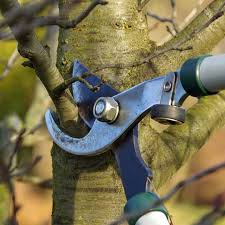The Importance of Pruning Trees
Q&A’s with Dave Gunn – St. Louis Aesthetic Pruning

Q: What is the purpose of pruning trees and why is it important?
A: When pruning, it is important to have a goal in mind. Why are we pruning? Reasons can include 1) to improve structural form at an early age, 2) to showcase aesthetic qualities, 3) to enhance flower and/or fruit production, 4) to address pest or disease issues and, 5) to mitigate hazards such as broken or dead limbs aloft. An analogy that I often use is that a tree in the wild does not require pruning, just as a wolf does not require training. However, when we bring a dog into our home, training is essential for both the dog and the humans, to ensure a better relationship. Similarly, training young trees in the landscape (through pruning) can lead to a tree that lives longer, is healthier, and often safer for those living under it. Humans also require training, as to be better stewards of the trees with whom they share space.
Q: How often should trees be pruned, and is there a specific time of the year that is best for pruning?
A: This depends a lot on the tree species and the goals of the pruning schedule. For example, in aesthetic pruning and fruit production, pruning is generally required every year, and sometimes these pruning schedules are rather intense.
For trees in the landscape, I think it comes down to monitoring and assessment. Very young and very old trees should be monitored and assessed annually. For young trees, it’s about establishing a good branching structure at an early age. For older trees, it’s about monitoring for diseases, pests, damage from storms, etc. Treatments such as pruning, cabling, or injections should be the result of something observed. Think of it like going to the doctor. You wouldn’t schedule yearly surgeries. Instead, we schedule yearly check-ups. If the doctor observes a problem, which might require medicine or surgery, then we have that discussion and develop a plan. There should always be a plan for the pruning.
The timing, again, depends a lot on species and goals. Recent scientific studies have shown that pruning in late winter/early spring usually can be less stressful to the tree, be less likely to attract pests and fungal pathogens, and can result in faster wound closure.
Dr. Ed Gilman with the University of Florida and Lindsey Purcell with Purdue have done some great presentations on this subject.
Q: What are the different types of pruning cuts, and when should each be used?
A: Four basic pruning cuts are 1) Thinning, 2) Reduction, 3) Heading, and 4) Removal of dead wood. Be aware though, that pruning is highly subjective and open to interpretation. There are probably as many pruning styles as there are people that prune. It’s very situational.
For homeowners, I think the most important things to know are how to make good collar cuts and implement the three-cut system, to reduce bark tearing. One should not leave stubs or make flush cuts. When hiring an arborist to do more extensive work, ensure that they are not performing practices known as “topping” or “lion-tailing”. These can be extremely harmful to trees, and lead to long-term problems.
Q: Can pruning a tree harm them, and what precautions should be taken to avoid damaging the tree?
A: Cass Turnbull, with the organization Plant Amnesty, has coined the term “mal-pruning”, which basically translates as bad pruning. Yes, poor pruning practices can be extremely harmful to trees. As with many things, the best way to avoid disaster is to either hire a professional or educate yourself.
When hiring a professional, look for someone calling themselves an arborist, as opposed to a “tree-trimmer”. An ISA Certified Arborist is usually your best choice (ISA is the International Society of Arboriculture). If you choose the self-education route, there are many resources out there. Locally, Missouri Botanical Garden, the Master Gardeners Program, and university extension services in Missouri and Illinois all hold classes and publish articles on the subject.
When performing online searches, be aware that there is a lot of misinformation out there. It’s best to stick with websites that end in .edu or .org, at least until you get your bearings. Cass Turnbull has a YouTube channel filled with some fantastic videos.
Q: How can you determine if a tree needs to be pruned, and what factors should be considered when making the decision to prune?
A: I’ll return to the doctor analogy we visited earlier. Think of pruning as a diagnosis meant to address a certain issue or satisfy a specific goal. It’s best to leave diagnostics to the professionals. However, those with an interest in plants, particularly avid gardeners, and horticulturists, who already have background knowledge of plant physiology and hormone responses, can take their knowledge one step further and pick up some books or visit websites covering the subject. For veteran plant nerds, the concepts and terms will be familiar and easy to adopt.
Dave Gunn is an ISA Certified Arborist (MW-5724A) and is also Tree Risk Assessment Qualified. He can be reached at 314.349.9438